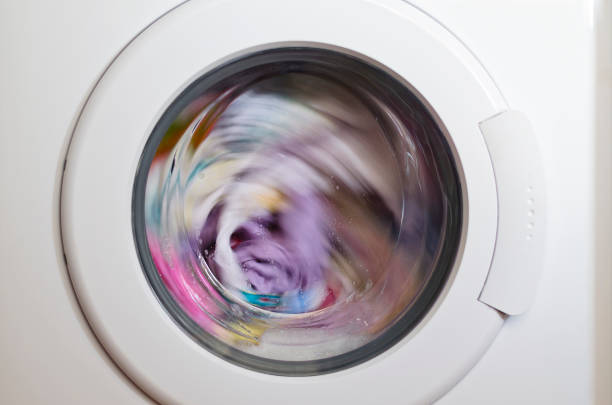The speed at which a washing machine’s drum rotates is a fascinating aspect of modern laundry technology. This rotational velocity, often measured in revolutions per minute (RPM), plays a crucial role in the cleaning process.
But how fast does a washing machine spin (MPH)? While a washing machine’s drum doesn’t reach speeds anywhere near typical miles-per-hour measurements, its spinning rate significantly impacts water extraction, detergent distribution, and overall cleaning efficiency.
Understanding the relationship between spin speed and laundry quality sheds light on the intricate mechanics behind achieving spotless garments while preserving fabric integrity.
How Fast Does a Washing Machine Spin (MPH)?
While different washing machines will have different speeds, most spin at around 1,000 to 1,600 rotations per minute. This means that they’re spinning at around 17 to 27 revolutions per second.
To convert this to miles per hour, you just need to multiply by the circumference of the drum. For a standard washing machine, this is usually about 30 inches, so you get something in the range of 510 to 810 mph.
There you have it: your washing machine is probably spinning somewhere between 510 and 810 miles per hour when it’s on!

The Conversion Conundrum: From RPM to Real-World MPH
While revolutions per minute (RPM) provide a clear metric for a washing machine’s spin speed, attempting to convert this unit to miles per hour (MPH) poses an intriguing challenge.
Unlike linear motion, where speed can be directly translated between different units, RPM involves circular motion, making the conversion complex.
The circumference of the drum might seem like a straightforward point of reference, but it doesn’t account for the machine’s size and structure, which impact the actual linear velocity of the drum’s edge.
Converting RPM to MPH involves more than a simple mathematical equation. It’s essential to consider the drum’s diameter, the machine’s mechanical design, and the diameter of the drum’s motion path.
Moreover, washing machines experience dynamic changes in velocity due to rotational mechanics. These factors defy a direct conversion from RPM to MPH, emphasizing that the two units measure entirely different concepts – circular rotations versus linear distance over time.
Ultimately, while it might be tempting to equate RPM with MPH, the unique mechanics of washing machines necessitate a more nuanced understanding of their spin speeds.
This conundrum showcases the intricate interplay of physics, engineering, and real-world application, underscoring the complexity of converting a rotational metric into a linear velocity measurement.
Factors Affecting Spin Speed
The spin speed of a washing machine is influenced by several crucial factors determining its efficiency in removing water from clothes.
- Type of Washing Machine: The design of the washing machine plays a significant role in determining its spin speed capabilities. Front-load washing machines often offer higher spin speeds compared to top-load models. This is due to front-loader mechanics, which can achieve faster spin speeds while maintaining stability.
- Model and Brand Variations: Different models and brands offer varying spin speeds within each type of washing machine. High-quality washing machine manufacturers tend to incorporate more advanced technology and engineering, allowing smoother and faster spin cycles. These variations can affect the overall cleaning and drying performance of the machine.
- High-end vs. Budget Models: The price range of washing machines directly impacts their spin speed capabilities. High-end models are more likely to offer a wider range of spin speed options, including extremely high speeds for efficient water extraction. On the other hand, budget-friendly machines might have limited spin speed settings, potentially affecting their ability to thoroughly dry clothes.
Also read: Can I Leave My Washing Machine On When I’m Out?
Things to Consider When Choosing the Spin Speed
Selecting the appropriate spin speed for your washing machine is a crucial decision that directly impacts the quality and longevity of your clothes.
Type of fabric and clothing
Different fabrics require varying levels of care. Delicate fabrics like silk, lace, and wool may suffer damage at high spin speeds, necessitating a gentler setting.
Sturdier fabrics like denim or cotton can tolerate higher spin speeds, ensuring thorough water extraction.
Delicate items vs. Sturdy fabrics
Delicate items such as lingerie or sweaters are better suited for lower spin speeds to prevent stretching, distortion, or tearing.
Sturdy fabrics, however, can benefit from higher speeds to reduce drying time and save energy.
Balancing energy efficiency and thorough cleaning
Opting for higher spin speeds can extract more water, reducing drying time and conserving energy. However, this balance depends on your laundry routine and the garments you frequently wash.
Noise and vibration at higher spin speeds
High spin speeds can generate increased noise and vibration, potentially causing disruptions. Ensuring your machine is properly balanced and maintained can mitigate these effects.
Wear and tear on clothing with high spin speeds
Extremely high spin speeds may cause wear and tear on clothing over time. This is particularly true for elastic fabrics and items with delicate embellishments.
Impact on the washing machine’s lifespan
Consistently using high spin speeds can exert additional strain on the washing machine’s motor and components, potentially shortening its lifespan.
Regular maintenance and adhering to manufacturer recommendations can help prolong the machine’s durability.

What’s the Benefit of a Faster Washing Machine?
A faster washing machine can remove more water from your clothes, which means that they will take less time to dry. This can save you money on your energy bill, as well as time if you’re using a clothesline or drying rack.
A faster washing machine can also help to prevent wrinkles. If you have a lot of laundry that needs to be ironed, a faster spin speed can help minimize the amount of ironing you’ll need.
Does a Faster Washing Machine Use More Electricity?
There is some debate about whether a faster washing machine uses more electricity. However, it may use more energy to spin at a higher speed.
On the other hand, using less water in the wash cycle can help to reduce your overall energy consumption since it will take less time and water to rinse your clothes once they come out of the washer.
In general, there are many factors that determine how much energy a washing machine consumes, such as its size, capacity, and efficiency ratings.
So, if you’re concerned about energy usage, you should do some research on different models to find one that meets your needs while also being efficient.
Conclusion
How fast does a washing machine spin (MPH)? The speed at which a washing machine spins varies among different models but typically falls within the range of 1,000 to 1,600 rotations per minute, equaling about 17 to 27 revolutions per second.
Converting this RPM to miles per hour, considering the average drum circumference of 30 inches, yields an approximate speed of 510 to 810 miles per hour.
So, when your washing machine is in action, it’s likely spinning at a surprising speed of 510 to 810 mph, efficiently removing water and giving new meaning to the term “laundry velocity.”







